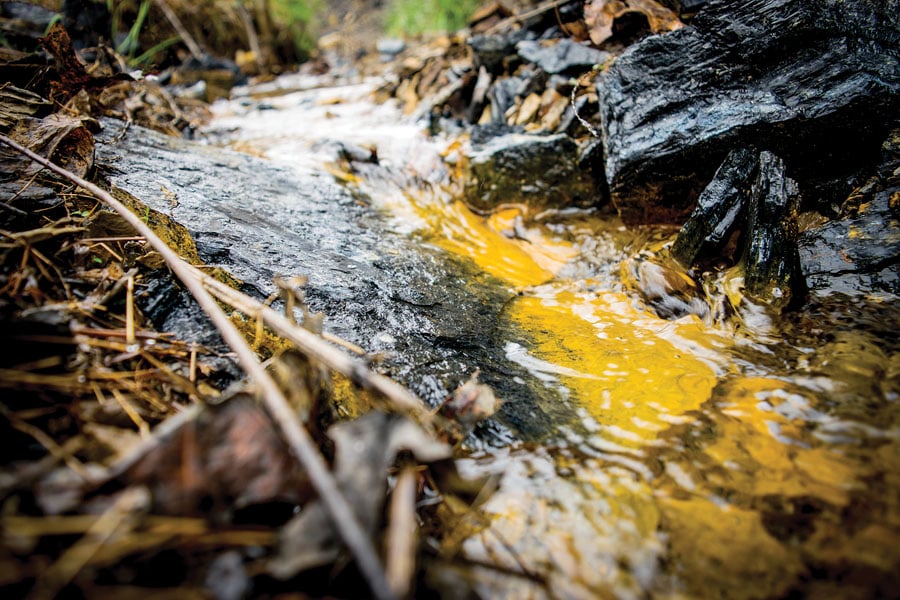“That’s not how a creek should look.”We peered between the pine slats of the bridge crossing Butcher Branch, a creek in southern West Virginia. It was early January. The four of us had been hiking through tunnels of frost-wilted rhododendron when we came upon the stream. None of us knew much about water quality, but we knew what a healthy stream should look like. The sight of Butcher Branch, milky and sediment-choked, was enough to stop us cold.
“Ain’t nothing living in there,” said one of the guys, scuffing his shoe on the bridge.
According to a 2011 environmental assessment by the National Park Service, there is a likelihood of “yet unknown sources of contamination” acquired from Butcher Branch’s passage through the old mining community of Kaymoor. The stream ran within the boundary of a national park, the New River Gorge National River. Shouldn’t its waters run clear?
In the Southeast and Mid-Atlantic, water quality issues seep from every hill and holler, and largely at the hands of coal mining. Coal-related repercussions such as acid mine drainage, coal slurry and coal ash impoundment failures, leaky underground wastewater injection sites, and valley fills are the number one threat to rivers and drinking water.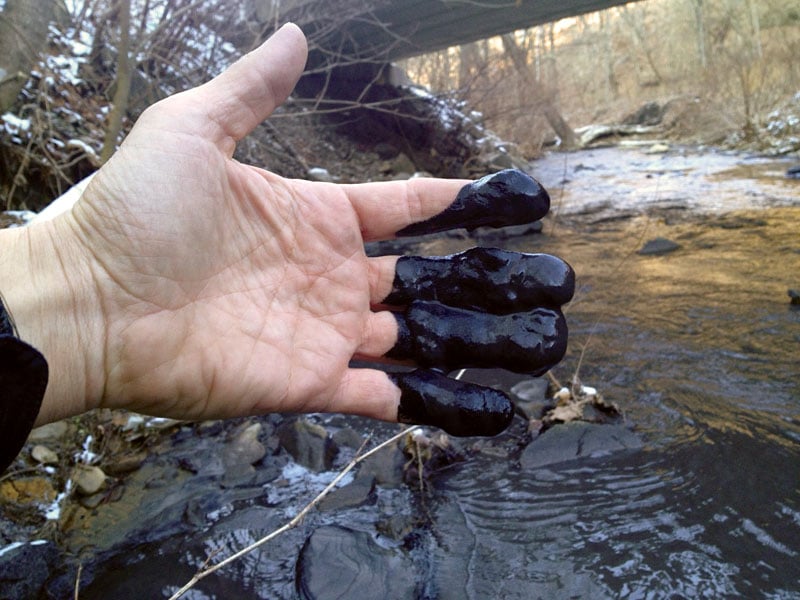
About the time I was walking over Butcher Branch, the city of Charleston, W.Va., was remembering with painful clarity the 2014 water crisis that left 300,000 West Virginians (that’s one-sixth of the state’s population) without safe drinking water. More than 10,000 gallons of 4-methylcyclohexane methanol (4MCHM) and PPH leaked from a Freedom Industries tank into the Elk River.
Just one month later in February 2014, a stormwater pipe that runs beneath a coal ash pond in Eden, N.C., broke, sending some 82,000 tons of coal ash into the Dan River. The toxic byproduct of burning coal, ash contains chemicals such as arsenic, selenium, and boron. It coated the Dan River’s bottom for 70 miles.
Back in December 2008, 1 billion gallons of coal ash flooded the Emory River in eastern Tennessee after a dyke collapsed at the Tennessee Valley Authority’s Kingston coal-fired power plant. The 60-foot wave of sludge was enough to destroy three homes and leave more than 300 acres of land covered in gray muck.
And nearly a decade before that, in October 2000, 306 million gallons of coal slurry burst through the bottom of a retaining pond at the Martin County Coal Corporation’s Big Branch impoundment near Inez, Ky. Over 100 miles of waterways turned black, more than a dozen communities lost their drinking water, and nearly all of the aquatic life from Inez to the Ohio River perished.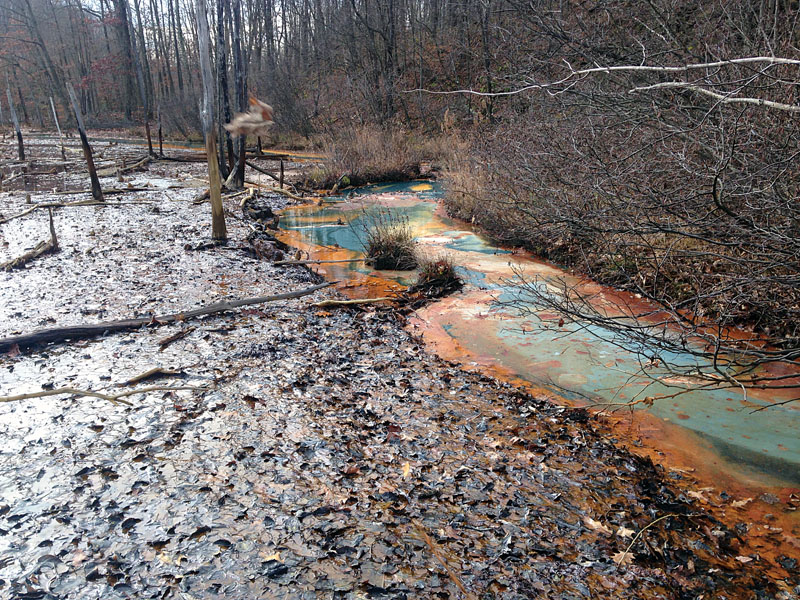 These are just the big spills. Sadly, spills and leaks occur every day. Duke Energy estimates that nearly three million gallons of contaminated water seeps out of its 32 coal ash pits on a daily basis. And where does it go? Into rivers, lakes, and drinking water.
These are just the big spills. Sadly, spills and leaks occur every day. Duke Energy estimates that nearly three million gallons of contaminated water seeps out of its 32 coal ash pits on a daily basis. And where does it go? Into rivers, lakes, and drinking water.
The implications of coal-related water contamination go beyond the physical pollution itself. According to the Environmental Protection Agency, living near a wet coal ash storage pond is comparable to smoking a pack of cigarettes a day. If you live within a one-mile radius of an unlined coal ash pond, your chances of cancer are 1 in 50—that’s 2,000 times higher than what the EPA considers acceptable.
OUT OF SIGHT, OUT OF MIND
If 72 percent of toxic water pollution in the country comes from coal-fired power plants, it would appear that the coal industry operates on its own terms. This is something Jennifer Hall-Massey of Boone County, W.Va., knows all too well.
In the early 2000s, about the time nearby coal companies began injecting coal slurry into abandoned underground mine shafts, Hall-Massey and her neighbors started noticing a difference in their tap water. The normally clean well water had acquired a terrible odor and oftentimes a cloudy gray color. Washing machines rusted and died, plumbing failed, and all the while, the county’s health was quickly deteriorating.
“I’m talking about elevated cases of miscarriages, dementia, cancer, all kind of skin ailments, rashes, intestinal ailments, too, and tooth loss,” says Dr. Ben Stout, a professor of biology at Wheeling Jesuit University in Wheeling, W.Va. “I met a kid who was 18 years old and had one tooth left and he was going to get dentures. It wasn’t because he didn’t brush his teeth—there was so much manganese in the water, they just rotted out.”
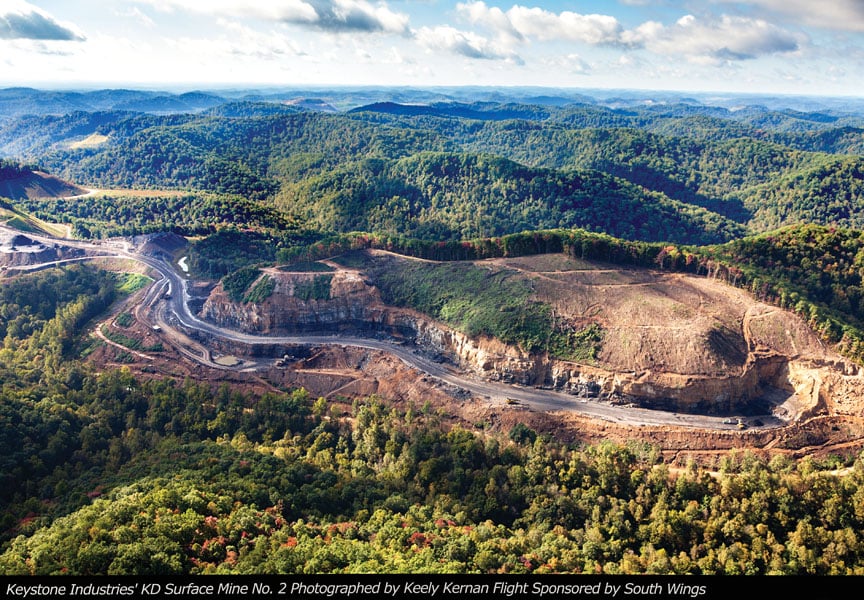
Hall-Massey’s now 14-year-old son also suffered from dental issues. Many of his baby teeth were capped due to enamel loss.
“The more he brushed with well water, the worse they were,” she says.
What’s more, a health survey revealed some 30 percent of Prenter area residents had their gallbladders removed. A few years after Boone County started taking note of the health and water quality of its community, Stout’s expertise was enlisted. With the help of a grant, Stout tested more than a dozen household taps in Prenter. The results unearthed shocking levels of arsenic, barium, lead, manganese, and other chemicals in the water.
“In a lot of the wells I’ve tested in southern West Virginia in general, they exceed manganese by 400 times,” Stout says. “With manganese, at those levels, you’re harming people.”
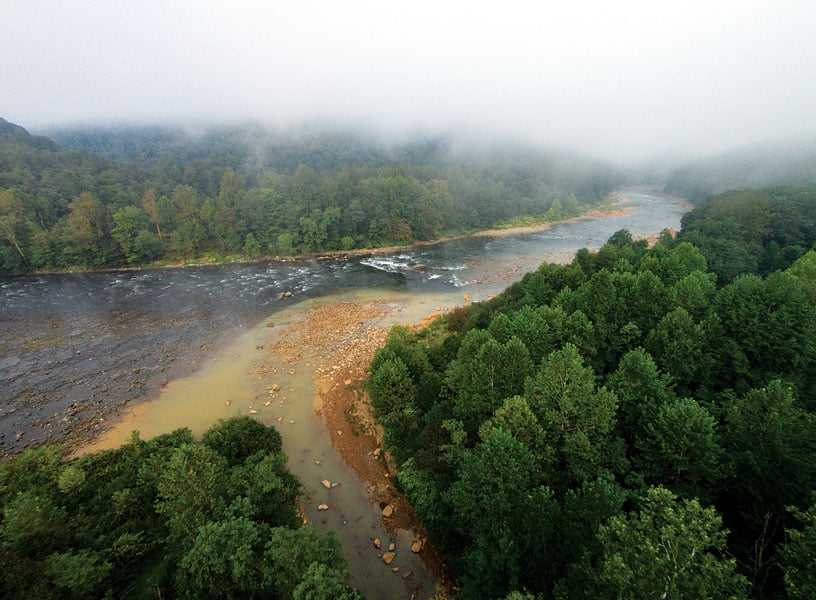
Hall-Massey didn’t need the science to prove what she had already witnessed in her community. At one of the earliest public awareness meetings in Prenter, Hall-Massey realized six of her neighbors in a 10-house span had brain tumors. Just one year prior to the meeting, her brother had passed away due to post-surgical complications with a brain tumor, which was reportedly non cancerous. Now, all but two of those six neighbors have passed away, too. And according to Hall-Massey, the afflicted neighbors were neither related nor similar in age.
Surprisingly, the health surveys and tap tests did little to convince state officials in Charleston, W.Va., that coal companies were to blame for Boone County’s water problems. Despite the fact that Prenter residents’ tap water was laden with chemicals identical to those found in coal slurry, coal companies remained adamant that they had chosen underground injection sites far away from Boone County’s residents to dispose of the sludge.
Yet the facts hardly support their argument. In just five years, coal companies injected nearly 2 billion gallons of coal slurry into abandoned mining shafts within an eight-mile radius of Hall-Massey’s home, 93 percent of which contained illegal concentrations of arsenic, lead, chromium, beryllium, and nickel. The pollution wasn’t a secret. By law, coal companies are required to report contamination to the state. The chemical concentrations found in nearby injection sites, which sometimes exceeded the legal limit by 1,000 percent, should, in theory, result in hefty fines and punishment for violating the Safe Drinking Water Act.
But the coal companies never incurred a penalty. The three key polluters—Loadout, Remington Coal, and Pine Ridge—never even received so much as a slap on the wrist. For Hall-Massey, the lack of enforcement confirmed her worst fear: no one is going to stand up to coal.
“Nobody gives a damn about the people living in this county,” she says. “We’re out of sight, out of mind. Personally, I could care less about the mountains. The people are what matters to me. You don’t risk lives and kill people to make a dollar.”
Hall-Massey refused to back down. Eventually in late 2010, a completed pipeline brought in city water to roughly 75 percent of Prenter households, but one-quarter of the town’s residents are still living with contaminated water. For those tapped into the city system, however, the health crisis lifted almost immediately. Asthma improved within days, skin rashes disappeared, and Hall-Massey’s son’s permanent teeth grew in perfectly normal.
THE COST OF DOING BUSINESS
Prenter residents were also some of the 300,000 affected by the Charleston water crisis in 2014. Instead of coal slurry seeping into their tap water, the residents now faced the unknown side effects of 4-MCHM. In 2015, Hall-Massey joined the 30 percent of her neighbors who have had their gallbladders removed. In her opinion, the timing of her surgery aligns perfectly with the 4-MCHM spill.
“No one knows the health effects and they will not know for years to come,” Hall-Massey says. “We’re a bunch of lab rats basically until time passes and someone collects the data.”
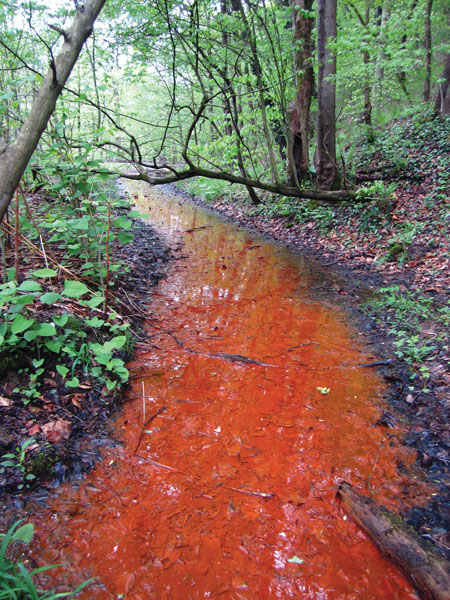
“The rest of the country treats us like we’re the cost of doing business in America,” agrees Daile Boulis, a resident of Loudendale, W.Va.
Boulis’ home is adjacent to Kanawha State Forest just nine miles outside of Charleston. During the 2014 water crisis, friends flocked to her doors to take showers, wash laundry, and fill up on water. Despite her home’s close proximity to the site of the spill, Boulis and her five neighbors along Middlelick Branch are still on well water.
But, Boulis fears, her clean well water likely will not last forever. As of December 2015, she says her water has acquired a slight metallic taste that she attributes to acid mine drainage from the nearby Keystone Development (KD) #2 mine. The mountaintop removal site, which lies just 1,500 feet from Boulis’s home and only 588 feet from Kanawha State Forest, has racked up more than 20 violations in just over two years. Though the West Virginia Department of Environmental Protection (WVDEP) halted work at the mine and placed Keystone and its operator, Revelation Energy, on the federal Office of Surface Mining’s Applicant Violator System, Boulis says it’s not enough.
“Their fines have been much less than the total of potential damage,” Boulis says. “[The violations] are big ones like method of operations and sediment control and fluid limits, all of which affect water quality.”
Unfortunately for Boulis and her neighbors, the damage to Davis Creek and the Kanawha Forest watershed has already been done. While Keystone and Revelation Energy cannot purchase any new mining permits, the designation by the WVDEP does not guarantee the companies will clean up the pollution, which leaves West Virginians with two options—accept a ruined watershed or pay the price to restore it.
CHEATED BY COAL
As demand for coal decreases, more coal companies are filing for bankruptcy. Forty-nine percent of the active mine permit holders in West Virginia have claimed bankruptcy. This equates to a drop in the coal severance tax, which, in conjunction with the bonds set aside by coal companies, helps fund reclamation.
“We are one catastrophic bankruptcy away from this fund being stressed out to the point that it won’t work,” says Randy Huffman, Cabinet Secretary for WVDEP. “When a coal company goes out of business, we revoke the permit and use their bond money, and money from the coal tax, to reclaim those mines to the current standards. [The bond] is never enough to do the work.”
The shortage of money has people like Amanda Pitzer, executive director of the non-profit Friends of the Cheat, wondering what happens next. Her organization and its volunteers are heavily involved in the reclamation process of the Cheat River Canyon, which suffered substantial damage due to an acid mine drainage blowout on Muddy Creek at the T&T Fuels mine in 1994 and 1995. It’s taken unrelenting persistence on behalf of Friends of the Cheat to make progress in cleaning up the Cheat River’s tributaries. After 20 years, a multi-million dollar treatment facility will finally be built near the site of the blowout.
“It’s a huge investment and it’s not a one-and-done. All of this stuff takes ongoing care,” Pitzer says,
According to the West Virginia Department of Environmental Protection, more than $35 million is needed to treat abandoned mine land sites and bond forfeiture sites. That figure doesn’t take into account the nearly $7 million required annually to maintain and operate these treatment plans, which involve adding doses of lime to waters polluted by acid mine drainage.
“It’s going to cost upwards of $10 million just to build the facility, plus operations and maintenance forever,” Pitzer says. “I mean, who is going to pay for that? What happens when you can’t pay to put the chemicals in the doser? Then what? Do we just let these creeks go back?”
For the Cheat River watershed, which not only provides a habitat for fish but also drinking water for some 45,000 residents and a means of recreational tourism for the town of Albright, abandoning treatment of the Cheat River’s tributaries is simply not an option. Following the mine blowouts in 1994 and 1995, the Cheat’s whitewater industry suffered a 50 percent drop in business. For a state that has historically fallen at the bottom of national economic charts, financial hits to any industry are not to be taken lightly.
POLLUTION SOLUTIONS
West Virginia is not alone in its struggle. Kentucky, Tennessee, Pennsylvania, and North Carolina are also fighting the realities of a dwindling coal economy, which include not just mine reclamation but also high rates of unemployment, poverty, and alarming trends in drug overdose and addiction.
“It’s really sad to see someone coming from a $60,000 mining job to a minimum wage groundskeeper,” says Dave Bassage, chief of staff at ACE Adventure Resort in Oak Hill, W.Va.
Bassage is uniquely sensitive to the plight of coal miners and the environmental impacts of West Virginia’s coal industry—before working for ACE, Bassage was a raft guide, a co-founder of Friends of the Cheat, and chief administrator of the WVDEP Office of Innovation for six years. Despite, or perhaps on account of, his diverse experiences in outdoor recreation, non-profit, and state government work, Bassage doesn’t see the use in pointing fingers. The issue of clean water isn’t just the problem of coal companies, or the state governments, or the environmental advocacy groups: it’s everybody’s problem.
“As a society, if we destroy our only home, that’s going to cost far more than whatever we invested to start with to take care of it,” Bassage says. “What we desperately need is a sense of future beyond extraction that’s something we can all wrap our arms around.”
There are programs and spending bills in effect to help displaced coal miners find employment, such as the Abandoned Mine Lands Program and Coalfield Development Corporation’s Reclaim Appalachia. President Obama’s proposed POWER+ Plan would distribute $1 billion toward economic initiatives in the coal-impacted communities of Virginia, West Virginia, Kentucky, and Tennessee. Investments in outdoor recreation tourism could also help stimulate dying economies in mountainous regions, given that the industry as a whole annually generates $646 billion in revenue and supports 6.1 million direct jobs.
But the solution isn’t going to be any one thing. The answer lies somewhere amid a muddled mess of economic diversification, investment in renewable energy, improved management and oversight of existing mines and potential pollution sites, and support for legislation like the Clean Water Rule—which would protect 60 percent of the nation’s streams and millions of acres of wetlands responsible for supplying drinking water to one in every three Americans.
“We all have concentric circles of values,” Bassage says. “At the core of that is our loved ones. Environmentalists have the same damn values as coal miners. Instead of focusing on those differences, if they focused on those shared values and found a way to care for their loved ones, that’s what will build a future.”
WATER IN AFRICA
A Problem and a Solution
In November 2015, I traveled to western Kenya and stood shoulder to shoulder with a group of Kenyan schoolchildren at their local water source. A piece of PVC pipe crudely jutted out from a red-clay embankment, trickling water slowly, but steadily.
BRO-TV: Follow the Liters from Blue Ridge Outdoors on Vimeo.
Not a few yards away, the spring sprouted to life from its underground casing. Clusters of tired-looking cattle stood idly upstream beneath a grove of acacia trees, staring with indifference at the uniformed line of children and jerry cans. One of the older girls managed the proceedings. She stood her ground at the head of the source, dutifully filling jug after jug. Her small biceps flexed as she passed full five-liter cans to their respective owners.
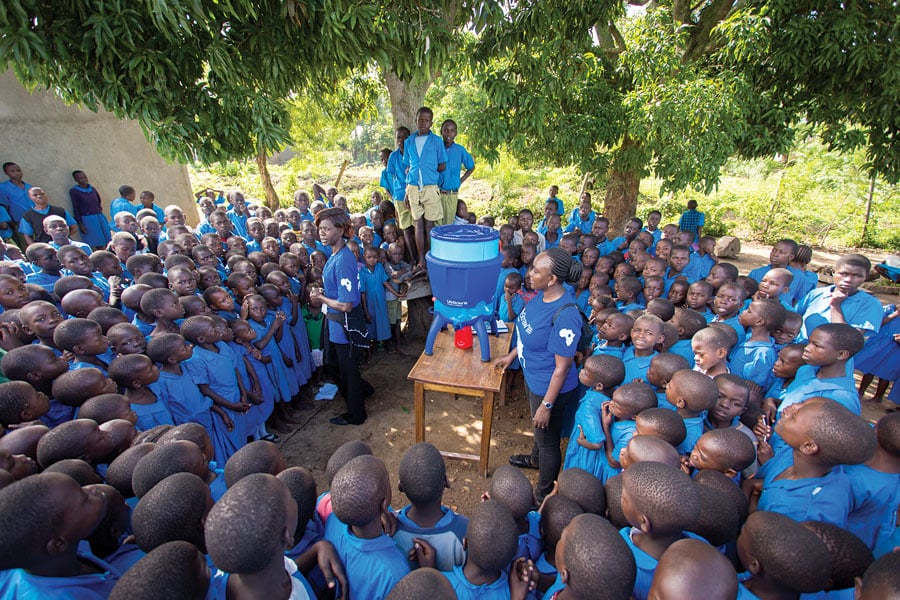
While she worked, I knelt closer to the pool beneath the spout, expecting to see my watery reflection staring back. The grimy green surface revealed nothing. Its foggy waters, I later learned, hid a world of microbiological contaminants that made students ill with cholera, giardia, and typhoid. Families struggle to afford doctor visits and medicine, leaving children to miss weeks of school.
Fortunately, at least for this school and the other 300-some schools our team would visit, the cycle of disease and absenteeism would eventually abate. Water filters from LifeStraw, which last three years, would replace the unreliable and inefficient methods of boiling and chlorination that were commonplace throughout rural Kenya.
To date, 361,000 students in western Kenya have benefited from this program, which includes not just the distribution of community water filters but also lessons in basic hygiene. Though that number pales in comparison to the 900 million still living without, it was a step in the right direction.
[divider]Related Articles[/divider]
